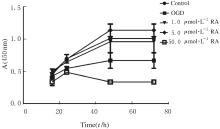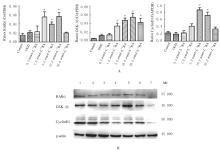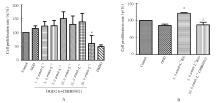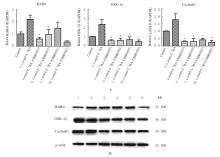吉林大学学报(医学版) ›› 2021, Vol. 47 ›› Issue (5): 1077-1085.doi: 10.13481/j.1671-587X.20210501
• 基础研究 • 下一篇
视黄酸通过GSK-3β对大鼠缺氧缺血性脑损伤后海马神经干细胞增殖的调节作用
李思雨1,2,赵敏1,2,杨茂玲1,2,肖农1,2,江伟1,2( )
)
- 1.重庆医科大学附属儿童医院康复科 儿童发育疾病研究教育部重点实验室 国家儿童健康与疾病 临床医学研究中心 儿童发育重大疾病国家国际科技合作基地,重庆 400014
2.儿科学重庆市重点 实验室 认知发育与学习记忆障碍转化医学重庆市重点实验室,重庆 400014
Regulatory effect of retinoic acid on proliferation of hippocampal neural stem cells after hypoxic-ischemic brain damage in rats via GSK-3β
Siyu LI1,2,Min ZHAO1,2,Maoling YANG1,2,Nong XIAO1,2,Wei JIANG1,2( )
)
- 1.Department of Rehabilitation,Ministry of Education Key Laboratory of Child Development and Disorders,National Clinical Research Center for Child Health and Disorders,China International Science and Technology Cooperation Base of Child Development and Critical Disorders,Children’s Hospital,Chongqing Medical University,Chongqing 400014,China
2.Chongqing Key Laboratory of Pediatrics,Chongqing Key Laboratory of Translational Medical Research in Cognitive Development and Learning and Memory Disorders,Chongqing 400014,China
摘要: 研究不同浓度视黄酸(RA)对大鼠缺氧缺血性脑损伤(HIBD)后海马神经干细胞增殖的影响,并探讨其可能的作用机制。 体外培养原代海马神经干细胞,并进行免疫荧光鉴定,对神经干细胞施以氧糖剥夺(OGD)损伤,模拟体内HIBD损伤。将细胞分为对照组、OGD组(0 μmol·L-1 RA干预)和不同浓度(0.5、1.0、5.0、10.0和50.0 μmol·L-1) RA干预组,CCK-8法检测OGD后12、24、48和72 h各组细胞增殖活性,实时荧光定量PCR(RT-qPCR)法和Western blotting法检测各组细胞中视黄酸核受体α(RARα)、糖原合酶激酶 3β(GSK-3β)和G1/S-特异性周期蛋白-D1(CyclinD1)mRNA表达水平和蛋白表达量。利用GSK-3β抑制剂CHIR99021处理不同浓度(0、0.5、5.0和50.0 μmol·L-1)RA干预后的海马神经干细胞,将细胞分为对照组,5.0 μmol·L-1 RA干预组,0、0.5、5.0和50.0 μmol·L-1 RA+20 μmol·L-1 CHIR99021干预组,CCK-8法检测OGD后24 h细胞增殖率,RT-qPCR法和Western blotting法检测各组细胞中RARα、GSK-3β和CyclinD1 mRNA表达水平和蛋白表达量。 免疫荧光鉴定,成功提取并培养原代海马神经干细胞。RA干预后的CCK-8法检测,与OGD组比较,1.0和5.0 μmol·L-1 RA干预组在OGD后各时间点细胞增殖活性均明显升高(P<0.05);RT-qPCR法和Western blotting法检测,与OGD组比较,5.0和10.0 μmol·L-1 RA干预组细胞中RARα、GSK-3β和CyclinD1 mRNA表达水平明显升高(P<0.05),1.0、5.0和10.0 μmol·L-1 RA干预组RARα和GSK-3β蛋白表达量增加。加入GSK-3β抑制剂CHIR99021干预后CCK-8法检测,与5.0 μmol·L-1 RA干预组比较,5.0 μmol·L-1 RA+20 μmol·L-1 CHIR99021干预组细胞增殖率明显降低(P<0.01);RT-qPCR法和Western blotting法检测,与5.0 μmol·L-1 RA干预组比较,0和0.5 μmol·L-1 RA+20 μmol·L-1 CHIR99021干预组细胞中RARα mRNA表达水平明显降低(P<0.01),0、0.5、5.0和50.0 μmol·L-1 RA+20 μmol·L-1 CHIR99021干预组细胞中GSK-3β和CyclinD1 mRNA表达水平均明显降低(P<0.05),GSK-3β和CyclinD1蛋白表达量减少。 RA促进HIBD损伤后神经干细胞增殖存在适宜浓度窗,其机制可能是RA通过激活GSK-3β调节CyclinD1的转录,进而促进神经干细胞增殖。
中图分类号:
- R493










